GROUP OF FOUR FAMILLE ROSE FIGURES OF TWO LADIES AND TWO BOYS
Further images
-
(View a larger image of thumbnail 1
)
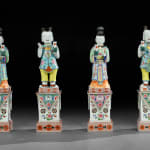
-
(View a larger image of thumbnail 2
)
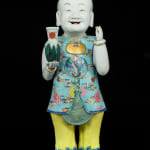
-
(View a larger image of thumbnail 3
)
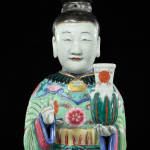
-
(View a larger image of thumbnail 4
)
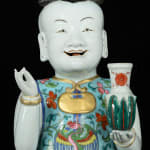
-
(View a larger image of thumbnail 5
)
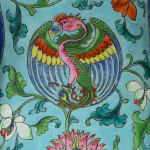
-
(View a larger image of thumbnail 6
)
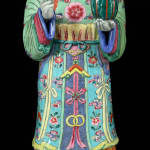
-
(View a larger image of thumbnail 7
)
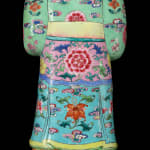
-
(View a larger image of thumbnail 8
)
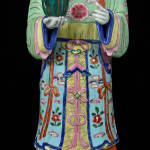
-
(View a larger image of thumbnail 9
)
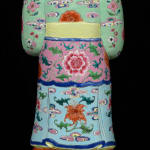
-
(View a larger image of thumbnail 10
)
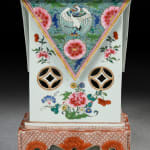
-
(View a larger image of thumbnail 11
)
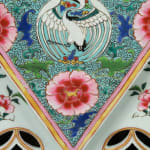
-
(View a larger image of thumbnail 12
)
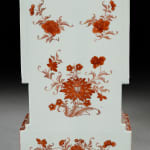
Provenance
Private Collection of the Societe Industrielle de Mulhouse, since early 20th century
Literature
COMPARE:
Galerie Gorges Petit, Objets d’Art Et d’Ameublement, Porcelaines De Chine (1914), pl. 104, for figures of a boy and lady of identical form and decoration
Edgar Gorer and J. F. Blacker, Chinese Porcelain and Hardstones, vol. II (1911), pl. 229, for a comparable boy and lady pair from the R. Bennett collection
Palace Museum in Gotha, Germany, c.f. the exhibition catalogue Schätze Chinas aus Museen der DDR, eds. H. Bräutigam, A. Eggebrecht, the Roemer and Pelizaeus Museum, Hildesheim 8 April - 15 July 1990, nos. 224-5, two famille verte figures of boys
Peabody Essex Museum, Salem, Massachusetts, USA, illustrated W. R. Sargent, Treasures of Chinese Export Ceramics from the Peabody Essex Museum (Massachusetts, 2012), p. 459-61, cat. no. 255, for a figure of a boy, also David S. Howard, A Tale of Three Cities (London, 1997), p. 135, fig. 171, and exhibited, sold Sotheby’s, 17 November 1999, lot 982, USD 188,917
Lady Lever Gallery in Liverpool, England, illustrated by R. L. Hobson in his Catalogue (1928), pls. 75-6 and Transactions of the Oriental Ceramic Society 35 (1963-4), p. 65, no. 228, another boy and lady pair
Collection of Ricardo do Espírito Santo Silva (formerly), illustrated Mary Lobo Antunes, Chinese Porcelain: Ricardo do Espírito Santo Silva Collection (Lisbon, 2000), p. 31, no. 9, and Maria Antónia Pinto de Matos, Porcelena Chinesa: De Presente Régio a Produto Commercial (Lisbon, 1998), p. 318-19, no. 124, for another boy pair
As H. Bräutigam commented, the phoenetic rebus ‘harmonious and peacefully united’ can be expressed either by the attribute of the lotus (he 驨, lian 皏), or by the demonstration of a vase (ping). With this combination of meaning, expressed by such expensive porcelain sculptures, Bräutigam suggested that such figures as these must have been made in connection with an aristocratic marriage.1
One boy figure is profusely decorated with lotus flowers issuing winding leafy stems with white and brick-red blooms. The Chinese name for the lotus rootstalk (ou, 毈) sounds like the Chinese word for ‘married couple’ (ou, 橪).2 And the Chinese word for lotus (he, 驨) is a homophone with the Chinese word for harmony (he, 和).
Another word for lotus, lian, sounds like the Chinese word for ‘continuous’ or ‘successive’. This refers to the wish for many children and reflects the connection between these and marriage, for which they have been present as gifts.3 Boys were long employed as helpful spirits for the production of male offspring. Greatly prized and precious, at just three months old they were given a lock (suo) of gold to wear around their neck to secure them to their family. Similarly, boys younger than sixteen wore bracelets made of nails from old coffins to deter evil spirits.4 The lobes of the present boy figures are also pierced, ready for earrings, as the pair formerly in the Ricardo do Espírito Santo Silva Collection feature earrings, which were supposed to delude evil spirits who were thought to look to injure male, but not female, children.5 In the same way, the boy figures each wear a phoenix (feng) decorated in the five colors of the cardinal virtues - benevolence, righteousness, propriety, knowledge and sincerity - all worthy aspirations in a boy.6
The marital and familial symbolism of the boy figures is enhanced by their female companions. Abounding between the ribbons of their dresses is plum blossom, whose five petals refer to the Five Blessings (wufu, 賟嗏): long life, wealth, health, virtue, and a peaceful death. Most importantly, though, the lower blue-turquoise portion of each robe bears a lily flower, baihe, which owing to similar pronunciation, can be interpreted to mean harmony and unity (hehe, 和合), and thus serves as a wedding symbol. Baihe is also part of the proverb bainian haohe (詄“湃錯), which means “happy union for one hundred years.”7 Brightly colored lilies, as the flowers here are orange, also represent passionate love.
This symbolism is carried through in the plinth bases, which each prominently features two openwork roundels representing the ‘sapeca’ (zhu) or gianwen, the Chinese symbol of wealth, securing material endowment of the male offspring.8 Beside these sections is the blue flower of the morning glory, symbolising marital bliss, love, affection and longing and which is also associated with a tale of two lovers who could only meet once a year. Lavish financial circumstances are also suggested by peony blossoms mudan and rosettes of the chrysanthemum on a hatched floral ground. The well-filled bag decorated with peony in front of the body of the boy is meant to protect the material goods, securing his fertility and the family line.9
The present set of four models is part of a small group of figures of this type that is preserved in private and institutional collections around the world.
A figure of a boy and another of lady practically identical in decoration are illustrated in Objets d’Art Et d’Ameublement, Porcelaines De Chine (1914), pl. 104 (Fig. 6.), published by the important leading dealer Galerie Gorges Petit of Rue de Sèze. A further comparable famille rose lady and boy pair from the collection of R. Bennett is illustrated in Gorer and Blacker’s definitive early study, Chinese Porcelain and Hardstones, vol. II (1911), pl. 229.
Two famille verte figures of boys are in the Palace Museum in Gotha, Germany and were published in the exhibition catalogue Schätze Chinas aus Museen der DDR, eds. Herbert Bräutigam and Arne Eggebrecht, at the Roemer and Pelizaeus Museum, Hildesheim 8 April - 15 July 1990, nos. 224-5. Another boy and lady pair is in the collection of the Lady Lever Gallery in Liverpool, England and were illustrated by R. L. Hobson in his famous Catalogue (1928), pls. 75-6.
A figure of a boy (missing its base) was included in the prestigious 1997 London exhibition A Tale of Three Cities: Canton, Shanghai and Hong Kong and published in the accompanying catalogue by David S. Howard (p. 135, fig. 171), where the author described the figure, identical in general conception and modelling to the present examples, as ‘an exceptional example in both size and quality.’ This example was ultimately purchased (Sotheby’s, 17 November 1999, lot 982, USD 188,917) for the Peabody Essex Museum, Salem, Massachussets and illustrated by William R. Sargent in Treasures of Chinese Export Ceramics from the Peabody Essex Museum (Massachusetts, 2012), p. 459-61, cat. no. 255
A boy pair was formerly in the Collection of Ricardo do Espírito Santo Silva, and was illustrated in Mary Lobo Antunes, Chinese Porcelain: Ricardo do Espírito Santo Silva Collection (Lisbon, 2000), p. 31, no. 9, and Maria Antónia Pinto de Matos, Porcelena Chinesa: De Presente Régio a Produto Commercial (Lisbon, 1998), p. 318-19, no. 124.
1 Schätze Chinas aus Museen der DDR, eds. H. Bräutigam, A. Eggebrecht, the Roemer and Pelizaeus Museum, Hildesheim 8 April - 15 July 1990, nos. 224-5
2 Smithsonian Museum, Washington D. C., Common Chinese Symbols, June 2020, accessed 17/01/2025
3 Idem.
4 W. R. Sargent, Treasures of Chinese Export Ceramics from the Peabody Essex Museum (Massachusetts, 2012), p. 461
5 Mary Lobo Antunes, Chinese Porcelain: Ricardo do Espírito Santo Silva Collection (Lisbon, 2000), p. 31, no. 9; Maria Antónia Pinto de Matos, Porcelena Chinesa: De Presente Régio a Produto Commercial (Lisbon, 1998), p. 318-19, no. 124; Sargent (2012), p. 461
6 Sotheby’s, Art at Auction, 1988-89 (London, 1989), p. 133; Sargent (2012), p. 461
7 Smithsonian Museum, Washington D. C., Common Chinese Symbols, June 2020, accessed 17/01/2025
8 Schätze Chinas, Bräutigam & Eggebrecht (1990), nos. 224-5
9 Idem.











